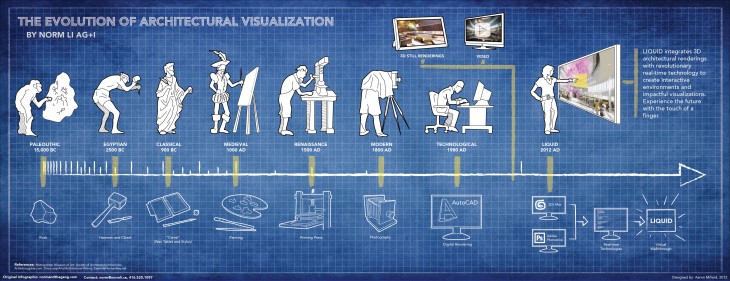Photo : http://normandthegang.com/2012/07/05/the-evolution-of-architectural-visualization/ by NORM LI AG+I
Text under study: TOWARD A THEORY OF ARCHITECTURE MACHINES by Nicholas Negroponte
With the evolution of architecture it can be clearly observed that not only has the architecture developed over time but so has the technology that helps in creating the design.
The technology refers to a number of items that would include materials, techniques and most prominently the digital tools that are used by almost all the architects today.
Nicholas Negroponte envisioned this growth in 1969 in his “towards theory of Architecture Machines” where in he not only anticipated computer aided design but also artificial intelligence.
The idea of the machine proposed is not merely a tool that does redundant tasks those which are already done by the designer. The machine in fact provides useful inputs and aids in the design process. They not only learn from the user but also improvise and evolve with the user themselves. Therefore it acts a means to expand the creativity of the user.
The ability of providing numerous solutions to specific inputs would be through the various assemblies in the system. These assemblies are metaphoric to the architectural design process that every designer goes through.
Good options would be rewarded and enhance the probability of better and optimum results. Having the ability to challenge and question would add to its capability along with being able to receive inputs from other means such as audio, visual and sensory. The vast information available to us today would hence be easier to grasp. This is also important because local information that is usually fed into system is as relevant as general information that surrounds us, which is ignored in the systems designed today. Thus the machine would learn by imitating the way humans learn and are influenced by the surrounding.
The idea of using technology beyond a tool may not be that alien to us in the present day and nor are the problems that would arise from it.
The fundamental questions still remain as to whom does the copyright of the output then belong to the man or the machine? The machine after all is designed by man but will the ultimate credit be given to the man or to the machine that would have a prominent role in the result of the product. If these act as a mean to better designs can it not result in numerous bad designs? Who again would be responsible for these outputs?
Although today a profound relation between the machine and the designer is not prominent in the field of architecture, the existence of this machine in the future is quite undeniable. This would not only ensure a means to enhance creativity but also experience a new kind of architecture with numerous possibilities.
POSSIBLE RESEARCH TOPIC
Understanding parallels between evolution of machines and architecture as a practice. The concept would revolve around redesigning the computer in the field of architecture.
To help comprehend the way in which computers have affected the design process and at the same time how new demands in architecture have forced the creation of new technologies. How they grow to affect each other in terms of the results generated.This would help build more relevant systems that are uniform across borders. Also to understand the expectations the systems have to achieve to be able to assist in the field of design.

